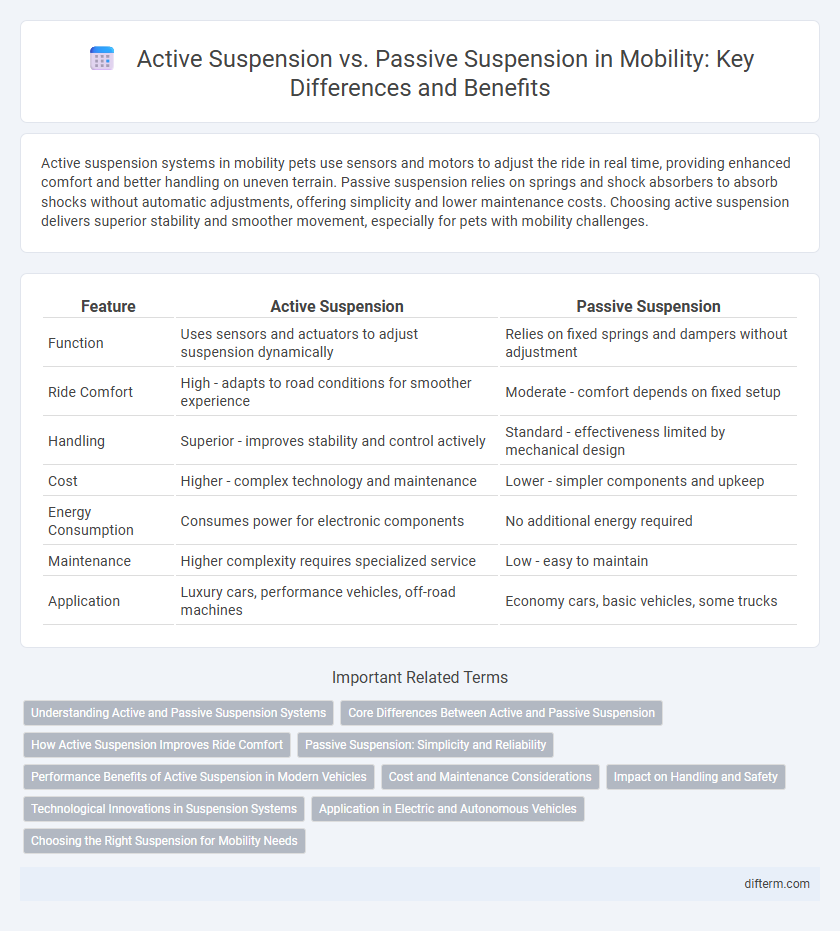Active suspension systems in mobility pets use sensors and motors to adjust the ride in real time, providing enhanced comfort and better handling on uneven terrain. Passive suspension relies on springs and shock absorbers to absorb shocks without automatic adjustments, offering simplicity and lower maintenance costs. Choosing active suspension delivers superior stability and smoother movement, especially for pets with mobility challenges.
Table of Comparison
| Feature | Active Suspension | Passive Suspension |
|---|---|---|
| Function | Uses sensors and actuators to adjust suspension dynamically | Relies on fixed springs and dampers without adjustment |
| Ride Comfort | High - adapts to road conditions for smoother experience | Moderate - comfort depends on fixed setup |
| Handling | Superior - improves stability and control actively | Standard - effectiveness limited by mechanical design |
| Cost | Higher - complex technology and maintenance | Lower - simpler components and upkeep |
| Energy Consumption | Consumes power for electronic components | No additional energy required |
| Maintenance | Higher complexity requires specialized service | Low - easy to maintain |
| Application | Luxury cars, performance vehicles, off-road machines | Economy cars, basic vehicles, some trucks |
Understanding Active and Passive Suspension Systems
Active suspension systems use sensors and actuators to continuously adjust the suspension settings, enhancing ride comfort and vehicle stability by dynamically responding to road conditions. Passive suspension systems rely on fixed mechanical components like springs and dampers, providing a consistent but less adaptable response to road irregularities. Understanding the technological differences highlights active suspension's superior control and adaptability compared to the simplicity and lower cost of passive suspension setups.
Core Differences Between Active and Passive Suspension
Active suspension systems use sensors and actuators to constantly adjust the suspension stiffness and damping, improving ride comfort and handling in real time. Passive suspension relies on fixed springs and shock absorbers designed to absorb road irregularities without dynamic adjustment. Core differences include responsiveness, complexity, and cost, with active suspensions offering superior control and adaptability compared to the simplicity and lower maintenance of passive systems.
How Active Suspension Improves Ride Comfort
Active suspension systems continuously adjust the damping and spring rates using sensors and electronic controls, significantly enhancing ride comfort by minimizing vibrations and road shocks. Unlike passive suspension, which relies on fixed components, active suspension dynamically responds to varying road conditions, delivering a smoother and more stable driving experience. This technology improves vehicle handling, reduces body roll, and absorbs uneven terrain impacts more effectively, resulting in superior passenger comfort.
Passive Suspension: Simplicity and Reliability
Passive suspension systems excel in simplicity and reliability due to their straightforward design with fixed springs and dampers, requiring no external power or complex components. These systems provide consistent performance with minimal maintenance, making them ideal for everyday vehicles and challenging terrains where dependability is crucial. The inherent robustness of passive suspension ensures durability and cost-effectiveness, contributing to long-term operational efficiency in various mobility applications.
Performance Benefits of Active Suspension in Modern Vehicles
Active suspension systems enhance vehicle performance by continuously adjusting damping forces in real time, improving ride comfort and handling precision compared to passive suspension. By using sensors and electronic controls, active suspension minimizes body roll, pitch, and vibrations, enabling superior stability and control during acceleration, braking, and cornering. Modern vehicles equipped with active suspension achieve better traction and dynamic response, contributing to improved safety and driving experience.
Cost and Maintenance Considerations
Active suspension systems incur higher upfront costs due to advanced components and electronics, demanding specialized maintenance compared to passive suspension. Maintenance for active suspension involves frequent calibration and potential software updates, increasing long-term expenses. Conversely, passive suspension offers lower initial costs and simpler, more cost-effective upkeep, making it preferable for budget-conscious mobility solutions.
Impact on Handling and Safety
Active suspension systems significantly enhance vehicle handling by continuously adjusting damping and spring rates based on road conditions, improving tire contact and stability during cornering and braking. Passive suspension models rely on fixed components, which can lead to reduced control on uneven surfaces and higher risk of skidding or loss of traction. By optimizing dynamic response, active suspension contributes to better safety outcomes, reducing the likelihood of accidents caused by poor vehicle handling.
Technological Innovations in Suspension Systems
Active suspension systems utilize advanced sensors and actuators to continuously adjust the damping and stiffness of vehicle springs, providing superior ride comfort and handling compared to passive suspension. Technological innovations include adaptive control algorithms and electromagnetic actuators that respond in real-time to road conditions, enhancing stability and reducing vibrations. These systems significantly outperform traditional passive suspensions, which rely on fixed mechanical components and lack dynamic adaptability.
Application in Electric and Autonomous Vehicles
Active suspension systems in electric and autonomous vehicles enhance ride comfort and handling by continuously adjusting damping and stiffness based on real-time sensor data. Unlike passive suspension, which relies on fixed mechanical components, active suspension improves energy efficiency and stability crucial for the precise control needed in autonomous driving. Integration with vehicle dynamics control systems enables active suspension to optimize traction and passenger safety during complex maneuvers and varying road conditions.
Choosing the Right Suspension for Mobility Needs
Active suspension systems enhance ride comfort and vehicle stability by continuously adjusting to road conditions using sensors and actuators, making them ideal for dynamic mobility needs and uneven terrains. Passive suspension relies on fixed springs and dampers, offering simplicity and lower maintenance costs but limited adaptability to varying driving conditions. Selecting the right suspension depends on factors such as terrain type, vehicle usage, and budget, with active suspension preferred for high-performance or off-road mobility and passive suspension suiting everyday driving within budget constraints.
active suspension vs passive suspension Infographic

 difterm.com
difterm.com